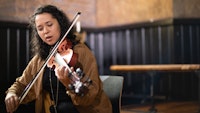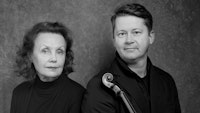Field of study: Artistic Research (Violin)
Karin Hellqvist: Transforming with the Artistic Palette

A practice-led exploration of performer creativity, agency and collaborative composition.
Summary
The central idea of the project is the conceptualization of the artistic palette. The artistic palette comprises the skills and abilities Hellqvist uses in creative work (skillabilities). It develops with the creative work she engages in and is active in imaginative and evaluative processes. The artistic palette has been explored in collaborative work with five composers as well as in an own composition. Hellqvist has explored it as a multidimensional concept, comprising embodied, contextual, relational and intuitive dimensions. By engaging with the artistic palette, new sonic materials and work methods have been created and she has shared compositional processes as a co-composer. It is a poetic and dynamic concept that keeps developing with her experiences. By using her artistic palette in shared work, Hellqvist has explored and expanded her creativity as a performer of contemporary classical music.
The five composers involved in the project come from a diverse background of styles, aesthetics and compositional approaches, such as minimalistic music, improvisation and music theatre. Some of the creative partnerships build on previous work together. The works created in the project are Gradients (2023) by Karin Hellqvist and Henrik Strindberg, Solastalgia (2022) by Carola Bauckholt and Karin Hellqvist, One and the Other (Speculative Polskas for Karin) (2021–22) by Liza Lim with Karin Hellqvist, Eiksmarka Omland (2024) by Christian Wallumrød and Karin Hellqvist, Pango (2021–24) by Karin Hellqvist and Chain of Triggers (2024) by Manos Tsangaris and Karin Hellqvist.
Through the artistic processes undertaken in this project, Hellqvist has experienced a transformation of her performer’s role into an increasingly creative one. From seeing herself as a faithful performer of works, she has come to view herself as a creating artist involved in the whole lifecycle of the works she performs and co-composes. By exploring the artistic palette in shared work, thoughts about connection, identity, responsibility, empowerment, complementarity, taste, ownership and transformation have come to the fore in her practice. Those topics are discussed across the works created in the project.
The methodology of the project is rooted in the specific forms of collaborative composition it comprises; engaging in improvisation, developing technological skills, accessing embodied performance materials, engaging in interdisciplinary work with a printed publication and developing connection through cyclical patterns of work where materials are circulated between participants. A curatorial process of selecting research material has been an important research method of the project along with text writing, peer-review and publication processes.
The structure of the reflection is a compilation of six case studies wrapped with an introduction and a closing discussion. The reflection has been created throughout the project and includes four already published articles. The project is situated in a broad artistic- and research field with connections to other collaborating performers and composers, artist-researchers who develop their performance practices, historical composer-performer collaborations and the rich artistic contexts of the involved artists. Hellqvist draws on theories of collaborative composition (Taylor, Lim, Östersjö, John-Steiner), Werktreue (Goehr), embodied knowledge (Merleau-Ponty, Lüneburg), eco-anxiety (Albrecht) and identity (Hargreaves, Markus & Nurius).
Documentation
Articles relevant
Published: Aug 14, 2018 — Last updated: Nov 19, 2025



